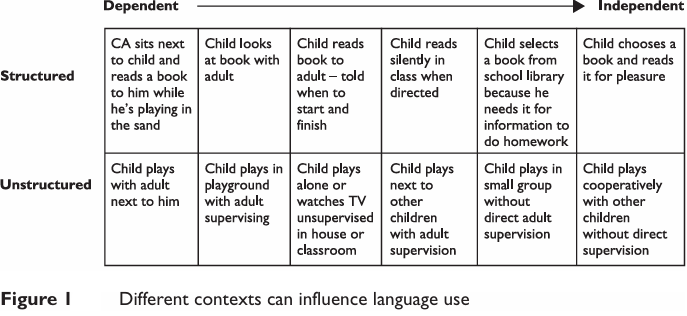


 Grammar
Grammar
 Tenses
Tenses
 Present
Present
 Past
Past
 Future
Future
 Parts Of Speech
Parts Of Speech
 Nouns
Nouns
 Verbs
Verbs
 Adverbs
Adverbs
 Adjectives
Adjectives
 Pronouns
Pronouns
 Pre Position
Pre Position
 Preposition by function
Preposition by function 
 Preposition by construction
Preposition by construction
 Conjunctions
Conjunctions
 Interjections
Interjections
 Grammar Rules
Grammar Rules
 Linguistics
Linguistics
 Semantics
Semantics
 Pragmatics
Pragmatics
 Reading Comprehension
Reading Comprehension
 Teaching Methods
Teaching Methods|
Read More
Date: 2025-04-04
Date: 2025-04-10
Date: 2025-04-04
|
Use of language
Obviously use of language is influenced by the social context. A child may well use language differently in a one-to-one structured setting in which the adult can give time and support to social communication. Figure 1 illustrates different contexts that may influence language use in the primary classroom.
This framework for social communication states that important variables include:
■ number of people involved in the communication;
■ amount of adult intervention;
■ type of activity: structured vs unstructured;
■ amount of social interaction required;
■ degree of autonomy needed.
It is important that staff work together when assessing the educational and social needs of pupils with SLCN. Keeping brief notes about the pupil’s response to support is crucial to effective monitoring and evaluation. Schools, quite appropriately, embed the assessment of SLCN within the whole-school framework for assessment. Assessment of progress in some curricular areas is particularly relevant in identifying the needs of pupils with SLCN. These include National Curriculum English ‘Speaking and Listening’ and the different levels that make up the framework of the National Literacy Strategy:
■ word level: phonics, spelling and vocabulary;
■ sentence level: grammar and punctuation;
■ text level: comprehension and composition.

Discussion
■ What do you consider the main purposes of assessment for learners with SLCN in your own setting?
■ How do you contribute to the assessment process in your own setting?
■ What effect does your assessment of pupil response to your support have on your own behavior?
■ How might you bring about improvements in using collaborative approaches to assessment to improve provision for learners with SCLN in your own setting?
■ To what extent do you involve the pupil in assessment of his/her learning?
|
|
|
|
دراسة: حفنة من الجوز يوميا تحميك من سرطان القولون
|
|
|
|
|
|
|
تنشيط أول مفاعل ملح منصهر يستعمل الثوريوم في العالم.. سباق "الأرنب والسلحفاة"
|
|
|
|
|
|
|
الطلبة المشاركون: مسابقة فنِّ الخطابة تمثل فرصة للتنافس الإبداعي وتنمية المهارات
|
|
|